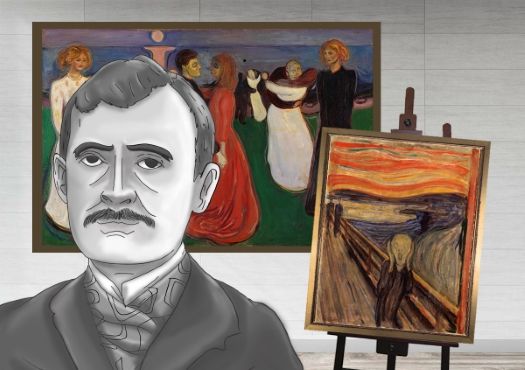
Modern art encompasses works created between the 1860s and the 1970s. It refers to the aesthetics and philosophy of art created during the time period. The creation of mechanical ways of recording pictures, such as photography and film, occurs during this time period. In a spirit of innovation, the phrase “modern art” typically refers to art in which old conventions have been abandoned.
Modern painters experimented with new methods of seeing as well as new notions about the nature of materials and art’s functions. Much modern art, especially minimalism, has a strong inclination toward abstraction. Contemporary art or Postmodern art are terms used to describe more contemporary creative work. While keeping this in mind, let’s take a look at some of the most interesting facts about modern art prints.
What is modern art?
When we hear the word “modern,” we immediately think of fresh, stylish, and fashionable items. The style and concept of artworks created between 1890 and 1960 may be simply defined as “Modern Art.”
In other words, the style included numerous Modern Art principles while focusing more on social, economic, and political issues. This was made feasible through the employment of innovative materials and components in the creation of art. The fundamental goal of Modern Art was to put aside the conventional customs of the past and focus on a new way of recognizing and evaluating the world’s present concerns.
How did Modern Art usher in a new era of art?
Many new thoughts and ideas were brought into the realm of art as a result of the modernism movement. As a result, many painters of the time began to focus their work on dreams, symbolism, and personal iconography. Other painters began experimenting with colour and non-traditional materials.
Many well-known painters, such as Pablo Picasso, were influenced by this, and with Modernism, he created a new style of painting. It was known as cubism, and it was recognized for its geometric shapes. Then, up until the 1830s, it evolved further. The development of art photography and film cameras gave painters new means to depict world scenes and drawings in their works.
Fauvism, Impressionism, Post-Impressionism, Dadaism, Cubism, Surrealism, Expressionism, Pop Art, and many more art forms are all characterized as part of the age of ‘Modernism.’ All of these helped to lay the groundwork for Modernism Art. A variety of elements inspired these art styles, including African and Asian art, light, culture, history, and so on.
Pablo Picasso, Vincent Van Gogh, Georges Seurat, Paul Cézanne, Andre Derain, Henri Matisse, Henri de Toulouse, Piet Mondrian, Raoul Dufy, Maurice de Vlaminck, Pierre-Auguste Renoir, Wassily Kandinsky, and Édouard Manet are just a handful of the most well-known ‘Modernist Masters.’
What is contemporary art?
Contemporary art, by definition, is art created since World War II and is used to characterize the works of artists who are currently alive and making artworks. Art critic Roger Fry formed the Contemporary Art Society in London in 1910, which was the first time the word was used. The word was used after WWII to describe the art movement.
It was regarded by critics as a period when “modern art” was no longer relevant enough to have a beneficial impact on future generations. The term contemporary has been used from the time of Modernism, but it was a specific form of work that did not refer to a specific historical period. Instead, it was focused only on current events such as social, economic, and political concerns.
Understanding the characteristics of contemporary art
Contemporary art generated experimental pieces that addressed a broader variety of social, economic, and political concerns. This concept mirrored current world concerns such as racism, globalization, oppression, poverty, and feminism, to name a few. Over the last 30 years, we’ve seen an increasing number of artworks that raise awareness of the most essential and pressing issues. Video art, salons, item designs, graphical arts, and social media were all prominent.
Contemporary art also appears to be addressing and revealing new concerns that will arise in the future. One of the most noticeable distinctions between Modern and Contemporary art is this.
There are numerous venues in the globe to see and experience both modern and contemporary art for those who are interested. Take, for example, New York, one of the greatest cities in the United States, which is home to some of the most valuable museums in the country, with many magnificent masterpieces.
What does the future hold for art?
Art has grown more accessible to a wider range of audiences and artists, thanks in large part to the advancement of new technologies. Despite all of the wonderful things our planet has to offer, the future will not be immune to unfavorable events.
With more of these technologies on the horizon, now is a fantastic moment to pursue a career as an artist. Learn about the best modern art museums to visit. Deep thinkers and extremely creative brains can achieve their goals and create a series of artworks on their own. This can help you amaze even the most ardent Modern Art aficionados by increasing their appreciation for contemporary art.
A quick recap of differences
The term “modern art” refers to art created after the 1880s. Contemporary art refers to the works of artists who are still alive and working now. Modern art is revolutionary because of its anti-romanticism origins, but Contemporary art is revolutionary because of the artists’ freedom and scope of experimentation.
Modern art is more self-expressive, whereas Contemporary art is concerned with society and is consequently recognized for its social effect. Modern art is generally created on canvases, but Contemporary art is created on any media imaginable, including video art, technologically enabled artworks, product design, and graphic arts.
Contemporary art takes a strong stance on social, political, and cultural elements of the world, whereas modern art concentrates on subjective depiction of chosen subjects.
Now you have a clear understanding about the differences between modern art and contemporary art. Whether you are a person who loves art, or you are interested in collecting art, you will need to keep these in your mind and go ahead.
